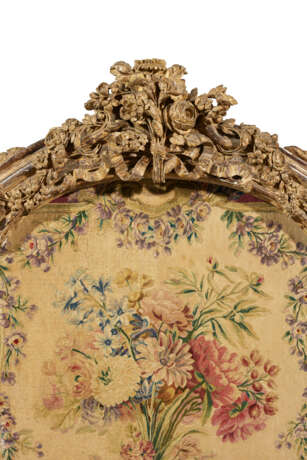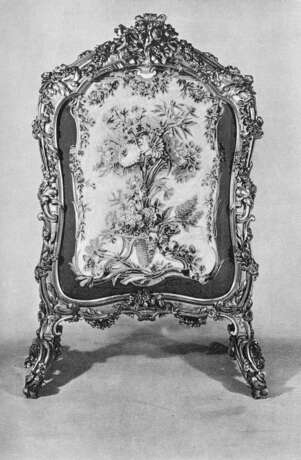ID 1329872
Los 15 | ÉCRAN DE CHEMINÉE DE LA FIN DE L'ÉPOQUE LOUIS XV
Schätzwert
€ 40 000 – 60 000
ATTRIBUÉ À NICOLAS HEURTAUT, LA TAPISSERIE DE LA MANUFACTURE ROYALE DES GOBELINS TRÈS PROBABLEMENT COMMANDÉE POUR LA MARQUISE DE POMPADOUR EN 1761,
SIGNÉE DE JACQUES NEILSON, D'APRÈS UN CARTON DE MAURICE JACQUES, VERS 1760
En hêtre mouluré, sculpté et doré, richement décoré de bouquets de roses, fleurettes, enroulements de feuilles d'acanthe et centré d'un noeud de rubans, le piètement orné de coquilles et de guirlandes de fleurs, la feuille en tapisserie des Gobelins à décor d'un bouquet de fleurs encadré d'un cartouche ceint de branchages fleuris, signée 'Nielson.ex' sur la partie basse, le revers de la feuille recouvert de soie damassée rouge à motifs floraux postérieure ; dorure en partie effacée
H. 138 cm. (54 ¼ in.) ; L. 90 cm. (35 ½ in.) ; P. 51 cm. (20 in.)
Provenance
Le panneau de tapisserie très probablement commandé pour la Marquise de Pompadour en 1761 auprès de la Manufacture des Gobelins pour son hôtel d’Evreux, et livré le 20 août 1764.
Charles Hindley & Sons, 1890, Londres.
Acquis en 1890 par Michael Arthur Bass, 1er Baron Burton (1837-1909) et installé dans le drawing room de sa residence du 6, Grosvenor Square, Londres;
Par descendance à Nellie Lisa Melles, 2eme Baroness Burton (1873-1962) jusqu’à sa vente;
Vente Christie’s, Londres, 22 novembre 1950, lot 319.
Literature
C.S. Sykes, Private Palaces, Life in the Great London houses, London, 1985
Further details
A LATE LOUIS XV GILT BEECHWOOD FIRESCREEN ATTRIBUTED TO NICOLAS HEURTAUT, TAPESTRY BY THE ROYAL MANUFACTURE OF GOBELINS, VERY PROBABLY COMMISSIONED BY THE MARQUISE DE POMPADOUR IN 1761, SIGNED BY JACQUES NEILSON, AFTER A DESIGN OF MAURICE JACQUES, CIRCA 1760
A commission from Madame de Pompadour
This fire screen, lavishly carved with flowers au naturel and covered with a tapestry panel from the Manufacture Royale des Gobelins signed by Jacques Nielson, is a discovery from a 1761 commission from Madame de Pompadour. This delivery is mentioned in the inventory following her death at the Hôtel d'Evreux, on August 20, 1764, in the following terms:
« Douze aunes trois seize un quart de tapisserie basse lisse, fabrique des Gobelins, représentant les Génies des Arts et sujets des Amours des Dieux, prix…8,000 Livres.
Le dessus de dix fauteuils complets en fleurs et ornements fond blanc et
mordorés, prisés… 1,200 livres
Les dessus de deux canapés de 7 pieds 6 p. de long sur 3 pieds 6 p. de profondeur, un sans dossier, prisés...800 livres
Un paravent de six feuilles de pareille tapisserie des Gobelins, prisé…600 livres
Un petit écran prisé…75 livres ».
This salon furniture was therefore intended to match the Amours des Dieux hangings that adorned the walls of the hôtel particulier. While the term “small screen” may seem surprising, given the majesty of this piece, it corresponds to a specific type of furniture used for fireplace screens. The Manufacture's registers list numerous orders for “small screens”, such as the one for Earl de Grey Vyner in Newby-Hall, or the one for the Marquis of Zetland, comparable in size to ours.
The set of furniture described in Madame de Pompadour's inventory corresponds in every respect to the suite of seat furniture comprising ten armchairs and two sofas now in the National Gallery of Art in Washington DC (Acc. Num. 1942.9.426-437). It displays the same abundant sculptural decoration, with openwork garlands of flowers entwining the rails, rich scrolls of acanthus leaves, bunches of roses wrapped in ribbons and, in the center of the sofa seat rail, a floral basket. The suite is also upholstered in the same Gobelins tapestries as the present lot, on a white background, decorated with bouquets of carnations, daffodils, roses and peonies framed by palm leaves and lilac branches.
These tapestries are precisely described in the Mémoires d'ouvrage de peinture by the ornamentalist Maurice Jacques in 1760:
« Plus avoir fait vingt dessins pour fauteuils tant fonds que dossiers, peints et coloriés à la gouache, formant différents groupes de fleurs dans les milieux renfermés d'une petite bordure de fleurs, pour déterminer le listel, à raison de 18 livres par dessin, fait cy....480 livres.
Accordé… 360 livres.
Plus avoir peint trois tableaux composés d'ornemens et fleurs, pour un paravent en forme de panneau, lesquels trois tableaux se répètent chacun deux fois pour former les six panneaux supérieurs dudit paravent, pour ce… 450 livres
Accordé… 400 livres
Plus un panneau aussi d'ornemens et fleurs, qui sert de passe-partout pour les six panneaux inférieurs du susdit paravent, pour ce...100 livres
Accordé… 80 livres
Plus avoir peint six tableaux de 4 p. 1/2 de haut sur 1 p. 8 p. de large formant six feuilles de paravent, composées d'ornemens et fleurs, pour chacun desdits tableaux 220 livres, fait pour les six la somme de…1.500 livres »
Of this commission, one carton remains, that of the aforementioned screen, now preserved at the Musée des Arts Décoratifs (Inv. A.18257) and identified in the Madame de Pompadour Exhibition catalogue (Cat. Exp. X. Salmon, Madame de Pompadour et les arts, cat. 172, p. 401).
This panel features the same floral decorations and brick background, described as “mordoré” in the Marquise's inventory following her death. In old French, this color refers to “ roux, vert mordoré. D'un rouge cerise ou mordoré" (Lapparent, Minér.,1899, p.549).
This prestigious commission for the Marquise follows, the one delivered to her brother, the Marquis de Marigny, superintendent of the King's buildings (1727-1781) one year earlier in 1759, comprising five armchairs, a sofa and a screen designed by Jacques Nielson, based on cartons by Maurice Jacques.
Several cartons from this series, now in the Mobilier National, (GOB-249-003-10 and GOB-249-003-24-25) feature the same motifs as those of Madame de Pompadour, but with a different chromatic range: a palette of blues and greens for him, and blues and pinks for the marquise. These similarities are the result of a certain artistic complicity between brother and sister: the chairs made for the Marquis de Marigny were actually brought and presented in 1759 to the Marquise de Pompadour's Parisian hotel, so that she could visualize their effect in her own interior. Having approved them, she had them sent back to the Gobelins, so that new versions could be reproduced, in her colors, to match the tapestries of the Tenture de l'Amour des Dieux hanging on her walls.
Madame de Pompadour was behind several commissions. The first was carried out between late 1751 and autumn 1752 for the Château de Bellevue, in Nielson's workshop, and supervised by Jean-Charles Garnier-d'Isle, after models by François Boucher, comprising four armchairs, four side-chairs and two bergères “aux jeux d'enfants”. The second commission from the favorite of the Gobelins, supervised by Jean-Charles Garnier-d'Isle and then Jacques-Germain Soufflot, was executed between 1755 and 1756 for the Château de Cressy, after Boucher, and named “aux enfants”.
The third order corresponds to our screen and the suite of salon furniture now in the National Gallery of Arts in Washington, was ordered in 1761 but not delivered until August 1764, four months after the death of Madame de Pompadour. A fourth and final set, comprising two sofas and six chairs covered with Gobelin tapestries depicting the arts, is described in the Marquise's 1764 after-death inventory for Ménard's salon de compagnie.
Nicolas Heurtaut (1720-1771): master sculptor and master carpenter, precursor of stylistic evolution
The outstanding sculptural qualities of this fire screen, with its treatment of volumes and the refinement of its ornamentation, immediately evokes the work of Nicolas Heurtaut, one of the only craftsmen to exercise a dual mastery of carpentry and sculpture in the history of 18th-century French furniture.
This duality gave him unprecedented creative freedom, as evidenced by the abundance and ornamental richness of the sculpture on this screen. This boldness of design, with its sculptural rocaille motifs, scrolls and foliage unfolding in high relief, is found on a large sofa with two portable confidents by Nicolas Heurtaut, illustrated in B. Pallot, L'art du siège au XVIIIe siècle en France, Paris, 1987, p. 238. They also feature the same extensive openwork decoration, used almost exclusively by Heurtaut, to catch the light. A number of the carpenter's masterpieces feature this powerful, liberal and abundant decoration, which is characteristic of his oeuvre: a canapé à joues with curved back (Patino Collection, London, 1983), illustrated in the aforementioned book, a sofa preserved at the Musée des Arts Décoratifs in Paris (Inv. 36627), the “à la polonaise” bed at the Château de Versailles (Inv. 3809), whose baldaquin of curves, counter-curves and garlands of flowers is illustrated in the same book; and also a series of six armchairs from the collection of Jean Wanecq, featuring the same play of curved moldings ending curled up (terminating in a scroll), giving all the “ importance to the sculpture that crushes the woods, appearing almost too thin ” as described by Bill Pallot in the aforementioned book (B. Pallot, L'art du siège au XVIIIe siècle en France, Paris, 1987, p. 225).
This suite of six armchairs from the collection of Jean Wanecq features the same delicately executed roses as seen in the present screen: round and slightly half-open, with finely carved petals one by one, they appear to have just bloomed. Heurtaut is the only carpenter capable of such refinement in the execution of his pieces, thanks to his dual mastery. In addition to the acanthus leaves and rose garlands common in 18th-century decor, Heurtaut added a variety of flowers, such as poppy blossoms, cornflowers and daisies, in various stages of maturity, from buds to almost burgeoning blossoms.
Still as a sculptor, he didn't always stamp his works, nor did he often leave identifiable marks on them, which may explain the absence of a stamp on this screen.
His dual skills as a carpenter and sculptor gave him the freedom to mix styles, anticipating and initiating the evolution of taste. Throughout his thirty years of activity, Heurtaut was keen to follow fashions in three different styles, but each time as a forerunner. For example, a carpenter's fire screen, illustrated in the aforementioned book, not stamped and made around 1755, features decoration comparable to our own, with rails covered with scrolls of foliage that gradually creep down to the floor, as seen on the consoles by Pierre Contant d'Ivry. But also like the latter, and like ours, this screen has a symmetrical silhouette with pure lines, illustrating the “rocaille symétrisé classicisant” style. In fact, with its symmetrical, flower-filled basket at the bottom, our screen already anticipates the Louis XVI style.
Nicolas Heurtaut exerted a major influence on the carpenters who worked in his workshop or collaborated with him: including Jean-Baptiste Tilliard, for whom he also carved some seats, Jean Avisse, and also Louis Delanois. A fire screen by the latter, made around 1770-1771 and preserved in the Louvre (OA 10219), evokes the harmony of styles to which his master aspired: the symmetry and sobriety of the screen's form, much more neoclassical than our own, is complemented by important Louis XV-style feet, adorned with abundant flower carving, with comparable openwork decoration, and probably inspired by Heurtaut.
| Adresse der Versteigerung |
CHRISTIE'S 9 Avenue Matignon 75008 Paris Frankreich | ||||||||||||||
|---|---|---|---|---|---|---|---|---|---|---|---|---|---|---|---|
| Vorschau |
| ||||||||||||||
| Telefon | +33 (0)1 40 76 85 85 | ||||||||||||||
| Fax | +33 (0)1 40 76 85 86 | ||||||||||||||
| Nutzungsbedingungen | Nutzungsbedingungen | ||||||||||||||
| Versand |
Postdienst Kurierdienst Selbstabholung | ||||||||||||||
| Zahlungsarten |
Banküberweisung | ||||||||||||||
| Geschäftszeiten | Geschäftszeiten
|













